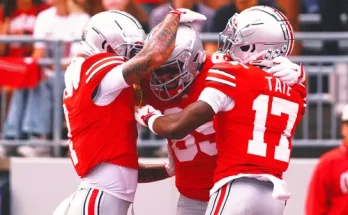Ohio State Enters Pivotal Time for Roster Building as Transfer Portal Opens
The opening of the NCAA transfer portal has brought new dynamics and opportunities to college football, and for a powerhouse program like Ohio State, the portal is both a challenge and a vital tool for continued success. As the Buckeyes embark on the 2025 offseason, they find themselves at a crucial juncture in roster building—one that will shape the program’s future and its ability to compete for national championships in the ever-evolving landscape of college football.
For years, Ohio State has been synonymous with elite recruiting, dominance in the Big Ten, and a constant contender for the College Football Playoff. However, with the increasing prevalence of the transfer portal, the Buckeyes now face a new challenge: how to blend the high school recruits they continue to bring in with players from other programs who may be looking for a new home. This period of roster construction will determine not just Ohio State’s success in 2025 but also its place in the future of college football.
As the portal opens for another cycle, Ohio State is entering a pivotal time in its pursuit of both immediate and long-term success. This article will explore how Ohio State plans to navigate the complexities of roster building in the transfer portal era, the strategic importance of the portal, and the opportunities and risks that come with it.
The Rise of the Transfer Portal: A New Era in College Football
The transfer portal, introduced in 2018, revolutionized college football by providing players with the ability to transfer between programs without the traditional restrictions and lengthy waiting periods. This was a game-changer in the college football landscape, allowing players to pursue new opportunities more easily. Over the past few years, the transfer portal has exploded in size and significance, with thousands of players entering each year, from high-profile starters to underutilized backups seeking playing time elsewhere.
While the transfer portal provides a level of freedom and mobility for players, it also forces programs to adapt to a new reality. For teams like Ohio State, who have long prided themselves on developing talent through recruiting and in-house development, the rise of the portal presents both opportunities and challenges. The Buckeyes’ recruiting ability has consistently been among the best in the country, but with other programs increasingly using the portal to fill gaps or bolster their rosters, Ohio State must remain vigilant in managing its roster through this new mechanism.
Ohio State’s Transfer Portal Strategy: Balancing Immediate Needs and Long-Term Goals
Ohio State is a program that has consistently built a championship-contending team through recruiting, player development, and strong program leadership. However, as the 2025 season approaches, head coach Ryan Day and his staff face the difficult task of balancing the influx of transfers with their long-standing commitment to high school recruiting. The key to Ohio State’s future success may lie in finding the right balance between nurturing homegrown talent and strategically utilizing the transfer portal to meet immediate needs.
- Filling Positional Gaps and Strengthening Depth
One of the primary reasons teams like Ohio State turn to the transfer portal is to address specific needs or weaknesses within their roster. No program is perfect, and even a powerhouse like Ohio State has areas where it might need immediate help. For example, as the Buckeyes head into the 2025 season, they could find themselves in need of reinforcements at certain positions, particularly on defense or the offensive line.
The 2024 season saw Ohio State’s defense, led by coordinator Jim Knowles, take significant steps forward, but there were still some growing pains. With the departure of key players to the NFL draft, including cornerback Cam Brown and defensive linemen like J.T. Tuimoloau and Zach Harrison, Ohio State may need to dip into the portal for experienced players who can step in immediately and contribute at a high level. Adding a proven pass rusher or a lockdown corner could be a priority to maintain the team’s defensive dominance.
On the offensive side of the ball, Ohio State has experienced consistent success with its quarterback and skill positions, but there are always areas where depth could be improved. The offensive line, for instance, is an area where Ohio State’s coaching staff could seek immediate help through the transfer portal, especially if there are any concerns about the development of younger players. If the team loses key players to the NFL or injuries, the portal could provide a lifeline for immediate contributors to maintain Ohio State’s offensive efficiency.
- Enhancing Competition and Building a Championship-Caliber Roster
The transfer portal doesn’t just allow teams to fill gaps—it also provides a way to inject competition into the program. At Ohio State, competition is a driving force behind success. Ryan Day has emphasized creating a culture of competition, where players understand that they must continually improve and perform to earn their playing time. The transfer portal can amplify this culture by adding experienced players who are hungry for the chance to play at a high level.
By bringing in transfers with a chip on their shoulder, Ohio State can create a more competitive environment, pushing its incumbent players to elevate their games. For example, adding an experienced linebacker or a skilled wide receiver can bring new energy to the team and push younger players to develop faster. This competitiveness can have a ripple effect across the entire roster, improving the overall talent pool and deepening the Buckeyes’ roster.
- Targeting Players with Ohio State’s ‘Culture Fit’
While the transfer portal can be a valuable tool, it’s also important for Ohio State to remain true to its culture and values when bringing in transfers. Players who enter the portal aren’t always looking for the same things, and Ohio State’s program is built around a strong sense of unity, discipline, and a commitment to developing talent over time. Ryan Day and his staff have consistently emphasized the importance of finding players who fit Ohio State’s program both on and off the field. This is especially crucial when evaluating transfers.
When adding transfers, Ohio State’s staff must consider not just the on-field ability of a player but also their character, work ethic, and ability to adapt to the team’s culture. This approach has been a hallmark of Ohio State’s success under Ryan Day and will be essential as the program continues to build through the portal. The Buckeyes are known for fostering a family-like atmosphere, and the right fit can help integrate a transfer seamlessly into the program’s culture.
- The Role of Transfers in Ohio State’s Long-Term Plans
While the immediate needs and depth are critical, Ohio State’s coaching staff must also consider the long-term implications of transfer portal additions. A program like Ohio State doesn’t just want to win games in the short term; it’s focused on sustaining success and continuing to contend for national championships year after year.
Incorporating transfers can help maintain a competitive roster, but it’s important that the Buckeyes continue to focus on high school recruiting as the foundation of their team. The transfer portal should be used to complement a strong recruiting class, not to replace it. Ohio State’s ability to continue attracting elite high school talent, while using the portal to plug specific holes, will be key to sustaining the program’s elite status.
Additionally, it’s vital that Ohio State doesn’t get too reliant on transfers. The program’s tradition of developing players from within—especially at positions like quarterback, running back, and linebacker—has been a defining factor in its success. For example, Ohio State has produced a long line of standout quarterbacks, from Justin Fields to C.J. Stroud, and its ability to develop young talent at key positions must remain a priority.
The Challenges of the Transfer Portal Era for Ohio State
While the transfer portal opens up new possibilities for roster building, it also comes with its own set of challenges. One of the biggest concerns for Ohio State—and any program—is roster management. The influx of transfer players can create difficult decisions, especially with scholarship limits and the need to ensure there is room for both incoming recruits and transfers. Balancing the needs of the current team while not sacrificing future success is an ongoing challenge for Ryan Day and his staff.
Another challenge lies in maintaining team chemistry. Integrating new players into an established program can be tricky, and the potential for disruption in the locker room is something Ohio State must handle carefully. Successful programs like Ohio State have managed to navigate these challenges in the past, but it will require careful planning, communication, and leadership.
Looking Ahead: Ohio State’s Path Forward in the Transfer Portal Era
As the transfer portal continues to reshape college football, Ohio State finds itself at a critical point in its history. The team has consistently been one of the best in the nation, but the portal era introduces new dynamics that must be managed effectively. If the Buckeyes can strike the right balance between recruiting, player development, and strategic transfers, they will remain a perennial powerhouse in college football.
Ohio State’s ability to adapt to the portal, while staying true to its core values and culture, will determine how the program fares in the years to come. With a committed coaching staff, a strong recruiting foundation, and a clear vision for success, the Buckeyes have the tools to thrive in this new era of college football. The 2025 offseason will be a crucial period for Ohio State as it builds its roster for the future—one that blends the best of recruiting, player development, and smart use of the transfer portal.



